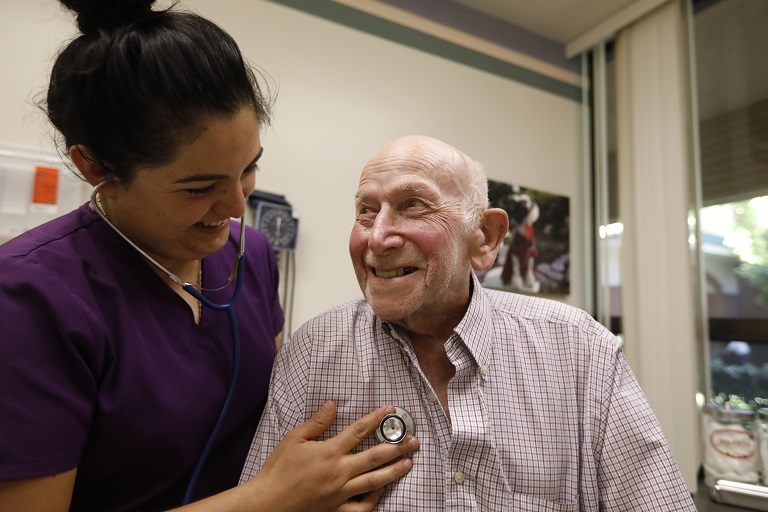The Senate Appropriations Committee approved the Fiscal Year (FY) 2024 Labor, Health and Human Services, Education, and Related Agencies Appropriations bill by a 26-2 vote on July 27. The bill is essentially flat-funded at FY23 levels—well below inflation—providing $224.4 billion in total discretionary spending. Senate appropriators will have to reconcile these funding levels with the House version of the bill, which provides $147 billion in total discretionary spending—a 30% cut to current levels.
This article below details key elements of the bill for LeadingAge members, including information on a LeadingAge-authored provision on hospice respite care and a number of other notable elements.
HHS Funding and General Provisions
- HHS Funding: The Senate bill funds the Department of Health and Human Services (HHS) at $117 billion, compared with the House version at $103.3 billion. The Centers for Disease Control and Prevention (CDC) would see nominal cuts due the lack of inflationary adjustments in the bill. The National Institutes of Health (NIH) would get a boost of $943 million, and Centers for Medicare & Medicaid Services (CMS) trust fund payments for Medicare and other programs would drop from $548 billion to $477 billion. However, CMS would receive a $40 billion increase for Medicaid state grants.
- State Survey and Certification Funding: The Committee provided $397,334,000 for State Survey and Certification activities, which ensure that institutions and agencies providing care to Medicare and Medicaid beneficiaries meet Federal health, safety, and program standards. This is below what the budget estimate was for the survey program and is the entire survey budget, not just for one service line. The Committee directed CMS to provide, in the FY25 Congressional Justification, a report to the Committees regarding operational milestones and funding activities. These reports shall also include operational metrics regarding the numbers and rates of survey and complaint visits by provider type for the applicable quarter.
Workforce
- Direct Care Workers: The Senate bill funds the Department of Labor’s (DOL) Training and Employment Services Account at approximately $4 billion. In the accompanying report, the committee notes its concern about worker shortages in the direct care sector, particularly regarding aging and disability care. It encourages DOL, in coordination with HHS and CMS, “to study the effects of worker shortages in the direct care sector and the impact that worker shortages will have on long-term care affordability and accessibility, and long-term care programs and submit a report to the Committees on Appropriations not later than 270 days after enactment.”
- Nursing Workforce Development: The bill provides $302 million for Nursing Workforce Development Programs under HHS, and the committee report recognizes the national workforce shortage and encourages the Health Resources and Services Administration (HRSA) “to provide traineeships and fellowships, including stipends, for eligible entities at both public and private institutions to expand opportunities that prepare individuals for careers in nursing.”
- LTC Worker Shortages: The committee further directs the Administration for Community Living (ACL), in coordination with DOL and CMS, “to examine data on the potential impacts of worker shortages on long-term care affordability and accessibility” and submit a report to the Committees on Appropriations not later than 120 days after the bill’s enactment.
Hospice and Palliative Care
- Hospice Respite Care: LeadingAge submitted language requesting a report from HHS on the current capacity and best practices for the provision of hospice respite care, including in the home. The update should assess and provide recommendations on what would be needed to ensure greater access to home respite care for hospice beneficiaries and their caregivers, including but not limited to changes to the current benefit to expand access to in-home respite. It should also evaluate the adequacy of the current five-day inpatient respite limit and make recommendations on parameters and situations in which an expanded eligibility definition and benefit duration might be appropriate. The Committee asked for this information in the FY25 budget justification from HHS and we are hopeful to use this information to advocate for expanded hospice respite care.
- Palliative Care: Notably, the bill provides $12.5 million for the National Institute on Aging (NIA) to implement a trans-Institute, multi-disease strategy to focus, expand, and intensify national research programs in palliative care. NIH is directed to establish a comprehensive multi-Institute and multi-Center initiative aimed at a wide variety of palliative care research, training, dissemination, and implementation of projects to intensify the strategic coordination of palliative care research efforts. The funding is also to establish an extramural-based palliative care research consortium to provide technical assistance, pilot and exploratory grant funding, research dissemination, data repositories, data analytics, and career development support for interdisciplinary palliative care. Further, the funding is supposed to go to early career development awards. In addition to the research funding, the Committee also encouraged HRSA to expand opportunities for training the palliative care workforce under existing programs.
Nursing Homes
- Post-Acute Workforce: The Committee report recognizes that “high-quality nursing staff are essential to patient safety and outcomes. As part of its accrediting oversight function, CMS is charged with ensuring that Medicare-participating hospitals meet important patient safety standards, including meeting appropriate nurse staffing requirements. The Committee encourages CMS to work with stakeholders to support the post-acute workforce, including by ensuring burdensome requirements do not result in decreased access for patients.” This language is an important reminder that lawmakers understand the implications of the anticipated CMS staffing mandate.
- Medical Director Transparency: The Committee report notes that it “continues to be concerned that post-acute and long-term care setting facility medical directors remain underutilized and invisible to most patients, families and others in the healthcare field. The Committee requests that CMS and the Secretary identify better ways for public health agencies to contact nursing facility medical directors with mechanisms like Care Compare or on data.cms.gov. This effort aligns with recent HHS proposed rule to increase the transparency of nursing home ownership and management through the administrative process.”
Home and Community Based Services including PACE
- HCBS: The Committee discussed home and community based services (HCBS) a few times throughout the Committee Report. They noted that they are supportive of efforts to increase access to care in homes and communities, which includes support for family caregivers and direct care workers that provide essential care and services and expects CMS to strengthen and expand access to HCBS within existing resources. As part of the funding for ACL, $410 million was allocated for the Home and Community Based Supportive Services program which, flowing through area agencies on aging, supports services such as transportation, adult day care, physical fitness programs, and in-home assistance.
- PACE: The Committee included the following report language on PACE: “… before the COVID–19 pandemic and during the COVID– 19 Public Health Emergency, Programs of All-Inclusive Care for the Elderly have been effective in keeping their medically complex, nursing home eligible population safe at home. Given the increasing demand for home and community based services by older adults and those living with disabilities, within 120 days of enactment of this act, the Committee directs the Secretary to submit a report providing details of an implementation plan for PACE specific model tests that examine methods of increasing access and affordability for Medicare and Medicaid beneficiaries.”
For more information, you can find the bill summary here, the bill text here, and the committee report here.

 Shutdown Week Three: Impact of Ongoing Closure on Affordable Housing
Shutdown Week Three: Impact of Ongoing Closure on Affordable Housing


